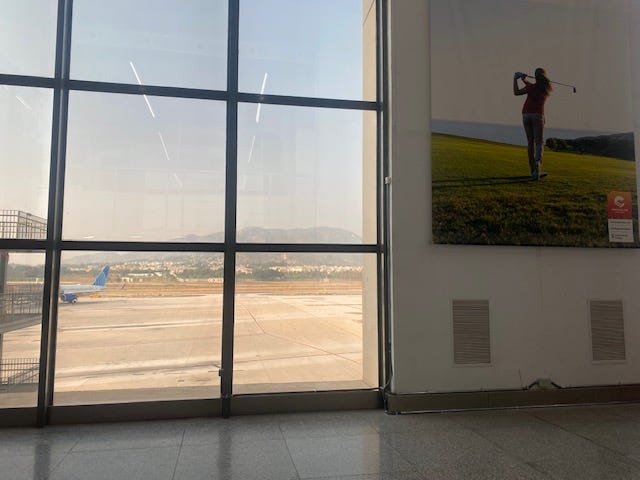This past Friday I flew to Málaga to give a keynote speech for DEAC, Spain’s annual convening of art museum educators (Departamentos de Educación y Acción Cultural de Museos). The conference was titled “Otro Lugar” (“Another Place”), focused on the role of the educator in reimagining the museum as site. My presentation focused on peripatetic practices, a subject that has occupied me recently. I spoke about 21st century versions of the Situationist’s dérive, and figurative and literal travel in socially engaged art and how education can learn and use artistic practices that involve walking or movement.
Because of my impossibly tight schedule, I had to travel all the way from New York to Málaga for the conference for a single day, and fly back immediately on Sunday in order to teach on Monday in New York. Then, on Sunday morning when I was scheduled to return, my United Airlines flight got delayed one hour, then for another hour, and then it was canceled altogether. That was only the beginning: the next morning, Monday, the airline seemed determined to use the same plane that didn’t work the day before and did not get to repair it on time, so my flight was delayed several times again for most of the day and eventually canceled for a second time. I was rescheduled yet again for another flight on Tuesday, which in fact got also delayed. After 3 days of waiting, I finally made it home.
I spent around 25 hours pacing up and down the airport terminal, paradoxically experiencing my own dose of dérive: in other words, after lecturing about movement and “other places” I was forced to waiting in the same place for days. So, the question for me became: if I preach psychogeography and peripatetic learning, what did I learn from this particular experience? I might as well write about it this week in order to “walk the talk” (pun intended), because, as Vladimir says in Waiting for Godot, “Let us not waste our time in idle discourse! Let us do something, while we have the chance!”
I drifted at the Málaga airport for most of the day those three days, looking at a group of toddlers play in their pajamas at the airport’s play area. There was a food stand next to my gate, B27, named Buy Bye; I got to practically memorize its products. I got to know the faces of the immigration police, the gate agents, and even the pilot and crew from my flight who were as stranded as I was. It started to feel like I had a job like them — mine being the one of a stranded passenger. Or maybe it was just the acting role of an extra in an absurdist play like Godot.



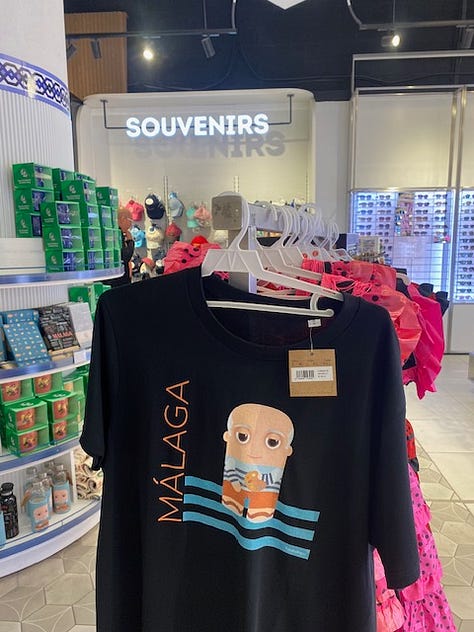

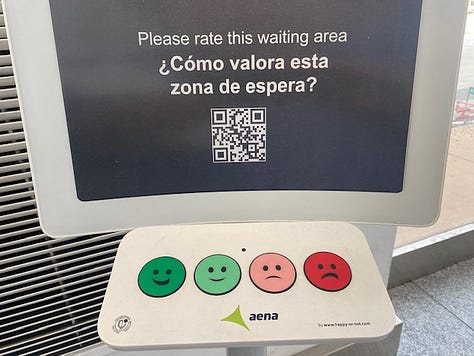
Airports in general have a negative psychological, oppressive, effect on me: they cause me great anxiety and the feeling of being dehumanized. It is a far cry to how used to see airports when I was a kid: they felt full of excitement, and going on a plane felt like a fancy adventure. So, amidst my waiting frustration I also felt a mixture of tender sweetness about these toddlers in the play area next to the gates, to whom everything is just a game, and also deep sadness and yearning of a distant childhood age when one does not have to worry about being at a particular place at a particular time.
After waiting for six or seven hours each day and the cancellation of that flight was official, us passengers were shuttled to a beach hotel paid by the airline, in Torremolinos, near Málaga. Torremolinos is a resort town in Costa del Sol, a popular destination for Northern European tourists, often described as the most un-Spanish place in Spain. Málaga in itself is an important cultural and tourist destination, one that has forged its identity around its favorite artist son, Pablo Picasso.
As the Director of Education of the Picasso Museum told me, Malagueños like to say that Málaga is where the artist was born and grew up as Pablo Ruiz, but left (to A Coruña, then to Madrid, to Barcelona, then to Paris and onto posterity) as Pablo Picasso. Every movement of young Picasso in that city is commemorated with a historic plaque. The Picasso cult creates such local exhaustion that there is are popular placards for sale in Málaga that read “Pablo Ruiz Picasso was never at this place.”
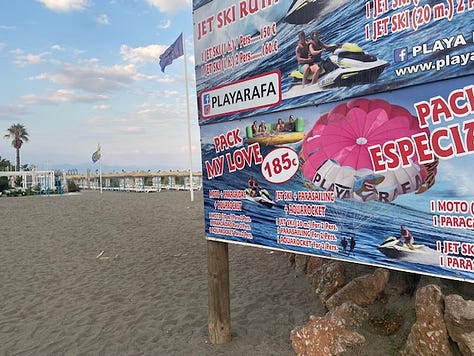

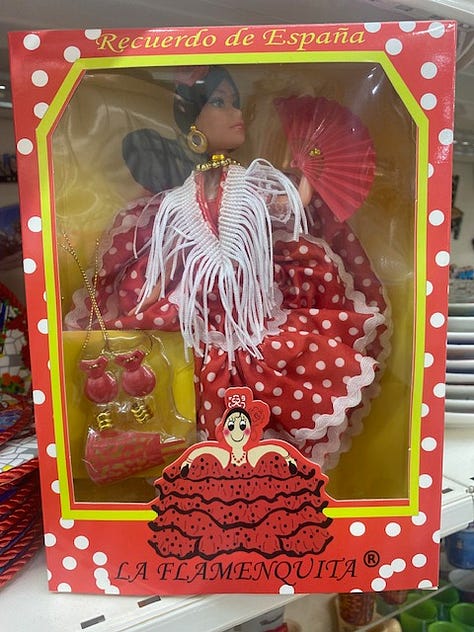


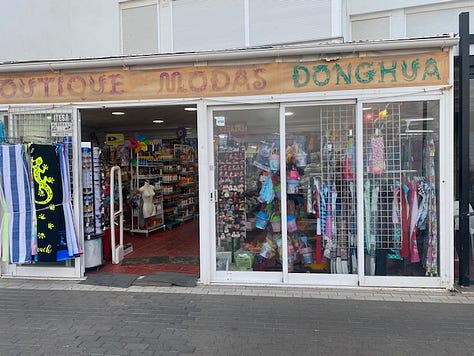
This sarcastic tone is of a piece with the frustration of locals with the onslaught of tourism which is both a nuisance and a vital source of revenue, a problem that plagues practically every other popular destination in Europe, from Venice to Mykonos— and, I suppose, Torremolinos.
I praise myself of having a high tolerance for kitsch and am often entertained by cheap crafts. But as I walked down the commercial streets of downtown Torremolinos, entirely lined by souvenir stores, my tolerance was challenged. Every castanet and ashtray looked like they have been (and most have been) mass-produced in China, which makes the souvenir a uniquely contradictory object: not an indigenous artifact that helps commemorate a trip, but a generic and spurious object whose only connection to the place labeled on it is that it was shipped there to be purchased at the souvenir shop (ironically, I found a Spanish souvenir shop named Donghua, similar to those dollar stores that can be found all over the US, literally selling imported Spanish souvenirs and altogether dispensing with the fiction that one goes to a souvenir store in order to shop local). As it turns out, and like in many other tourist beach resorts, a good portion of the seafood consumed at the touristy restaurants alongside the Costa del Sol is not local catch: because of high demand and overfishing, a lot of that seafood has been shipped frozen from elsewhere. So, this unexpected dérive detour in Torremolinos, made me think about how capitalism and the drive for consumption of authenticity paradoxically result in liminal spaces. I am in a non-place that sells the dream of the genuine, with objects and food from elsewhere. The Norwegian tourist next to me who is having a cod dish and wearing an “I love Spain” T shirt does not likely know, nor really care, that his T shirt was made in Asia nor that this fish was likely fished in his own home country and shipped there, frozen. We desperately want to purchase authenticity of experience, but we are very happy to instead be served liminality and its attending simulations.
--
Liminality and angst are interrelated. To explore that idea, in 2016 I conducted an experimental, education-as-art seminar in Mexico City titled “Curso profesional de capacitación y Desarrollo profesional del Limbo” (“Training Seminar on the Professional Development of Limbo ”) where we explored the interstitial space in art practice from as many angles as possible: social, temporal, geographical, political, and of course artistic. We concluded the seminar with a collective performance presented at Santo Domingo Church downtown where a group performed a piece by modern Mexican composer Julián Carrillo, who developed Sonido 13 (a method of microtonal music based on creating notes that land somewhere in between the 12 semitones of the tempered scale). At the entrance of the church we laid out a quote, with ephemeral color sand, from Dante’s unbaptized souls in Inferno: "We are condemned for no other fault than this: that we lived without the light of Christ, and our punishment is to live with the longing for the divine without hope of ever achieving it."
As I speak of liminal angst, I am fully aware that to write about being stranded at an airport with the world confronting real social and political crises feels bourgeois and frivolous, and my friends pointed it out to me, with comments such as “Oh, what a tragedy, being in Málaga”, and “there are worse places to be”. They are completely right, and by no means I wanted to generate sympathy. I only wanted to share these reflections about interstitial existence, which expresses itself in so many ways today. Which is why I want to end with a few thoughts regarding the ultimate story about being stranded at an airport: the case of Meran Karimi Nasseri.
My gate, B27, the one that I monitored over the course of 3 days, was next to a food stand named Buy Bye. Turns out that a bench at a similarly named airport franchise, the Bye Bye Bar at Charles de Gaulle airport in Paris, next to gate B2, was where Nasseri, an Iranian psychologist, lived from 1988 to 2006. Nasseri was mugged when he flew from London to Paris, losing his passport, and was unable to continue his journey. His story became so famous that in 2004 Stephen Spielberg made a film about him, The Terminal, starring Tom Hanks. Nasseri wrote a book about his life, titled Terminal Man, upon which the movie is based.
Nasseri’s account in his book is sad and touching. He describes his life at an airport bench where a recorded message, “Passengers are reminded to keep their personal baggage with them at all times”, plays every 10 minutes nonstop, 24 hours a day, as a nightmarish mantra and a one-phrase metaphor about possession and loss.
In his book, he writes:
“I have been sitting on my red bench from the Bye Bye Bar in the middle of Charles de Gaulle airport waiting to leave for fifteen years […]My red bench is on the lower floor of Terminal One – a slab of 1960s concrete shaped like a doughnut ring. Behind my red bench, a large glass window looks out onto the little open-air section at the very centre of the ring. It used to contain a fountain spouting water eighteen hours a day. The water kept getting dirty, so a few months ago the fountain was replaced by a garden planted with an uneasy mixture of palm trees and Christmas trees. I do not know if the garden will stay. I like the garden better because it makes less noise than the fountain so it is easier to get to sleep. Above the new garden, escalators in silver walkways cut across the skyline, carrying passengers towards the planes that sit docked and waiting around the exterior of the terminal. You can get to anywhere in the world from here.”
In a transient place that is designed to help travelers reach every confine in the planet, Nasseri’s world is reduced to looking out the window to watch that garden with the “uneasy mixture of palm trees and Christmas trees.” He figured out a routine and a version of domestic life, with an airport dry cleaners that dry cleaned his suit, and an airport mail office that would deliver him letters, until they decided to stop, after which he would not receive any letters.
Perhaps the most poignant and sorrowful aspect of his story to me is his eventual break with his own origin. When asked if he had any family, he replied, “I don’t have any family. They are lost.” And, more importantly, when asked if he was from Iran, he would reply: “No, my point of origin is not decided. I am not Iranian. That was a false identity.”
Nasseri’s perspective was in fact Existentialist, aligned with Soren Kierkegaard’s ideas in The Concept of Anxiety, where he argues that the anxiety we develop about the unknown feature ultimately results in uncertainty about the self, including things that before felt unquestionable, like one’s own origin.
This is perhaps the lesson of living in an interstitial reality: as it becomes our ultimate identity and we can’t fight it, all we have left is to embrace that psychogeographic, transitional space, accepting it as the only viable condition. According to Vladimir, knowing that we are waiting should suffice as the answer: “And we are blessed in this, that we happen to know the answer”.





